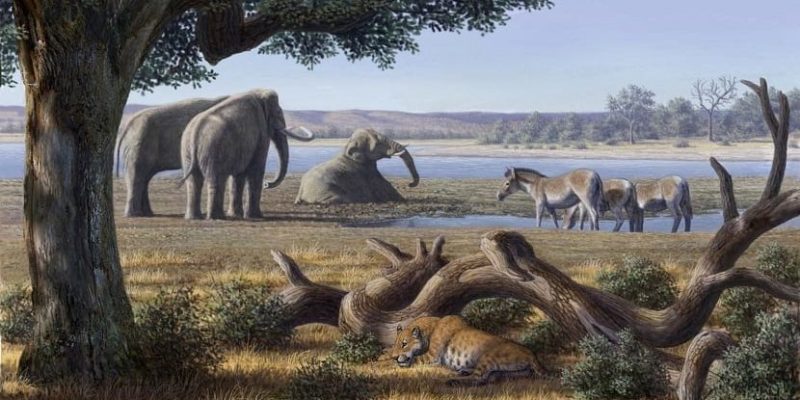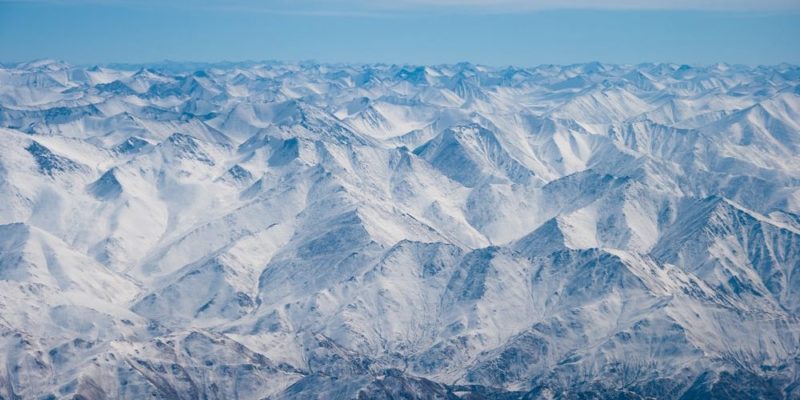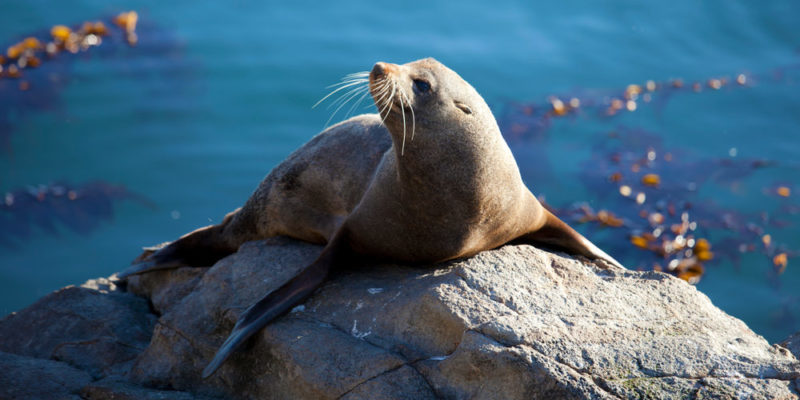We explain what the Tertiary Period was, how it is divided and the climate it presents. Also, what are its characteristics, flora and fauna.
What was the Tertiary period?
On the geological time scale, the first stage of the Cenozoic Era (started 66 million years ago and continues to the present day) was commonly called the Tertiary Period , also known in the past as the Tertiary Era. However, both (both Tertiary Era and Tertiary period) are disused terms.
At present, the name Cenozoic Era is preferred for the total time span between the extinction of the dinosaurs and the present, which is divided into three periods called Paleogene, Neogene, and Quaternary . What was previously called the Tertiary Period is today called the Paleogene and Neogene .
The Paleogene and Neogene periods constituted a time of resurgence of life , with a new predominant form of life that found a free field to proliferate and diversify: mammals . For this reason, the Cenozoic Era (whose name comes from the Greek kainos , “new”, and zoe , “life”, “animal”) is known as the “Age of mammals”.
Disuse of the term
The decision to replace the term "Tertiary" by Paleogene and Neogene was made at the beginning of the 20th century , leaving the initial term as a "sub-era" of the Cenozoic.
At the beginning of the XXI century (2008) the term was definitively abandoned by the International Commission of Stratigraphy . Since then, it has been omitted in current academic texts .
Instead, the periods are indicated:
- Paleogene. From 66 million years ago to approximately 28.1 million years ago.
- Neogene. From 23 million years ago to approximately 3.6 million years ago.
Cenozoic Era Division

The Cenozoic Era was divided into three periods, each one divided in turn into 2 or 3 epochs and these in a varied number of ages. We detail it all below:
IT WAS CENOZOIC
- Paleogene period. It begins 66 million years ago and lasts until approximately 28.1 million years ago. It is divided into three epochs:
- Paleocene. From 66 million years ago to 59.2 million years ago, including the Danish, Selandian and Thanetian ages.
- Eocene. From 56 million years ago to 38 million years ago, including the Ypresian, Lutetian, Bartonian, and Priabonian ages.
- Oligocene. From 33.9 million years ago to 28.1 million years ago, including the Rupelian and Chattian ages.
- Neogene Period. It begins 23 million years ago and ends approximately 3.6 million years ago. It comprises two epochs:
- Miocene. From 23 million years ago to 7.2 million years ago, spanning the Aquitaine, Burdigalian, Langhian, Serravalian, Tortonian, and Messinian ages.
- Pliocene. From 5.3 million years ago to 3.6 million years ago, spanning the Zanclian and Piacenzian ages.
- Quaternary Period. From 2.5 million years ago until the emergence of human civilization (and the beginning of History ), spanning two eras:
- Pleistocene. From 2.5 million years ago to about 126,000 years ago, spanning the Gelasian, Calabrian, Ionian or Middle Pleistocene and Tarantian or Upper or Late Pleistocene ages.
- Holocene. From approximately 11,700 years ago to the present, without ages.
Geological characteristics of the Tertiary
 Both the Paleogene and the Neogene were times of enormous geological and oceanographic changes . The fragmentation of Pangea , which had begun 100 million years ago, was completed, especially with the separation of its southern part, known as Gondwana.
Both the Paleogene and the Neogene were times of enormous geological and oceanographic changes . The fragmentation of Pangea , which had begun 100 million years ago, was completed, especially with the separation of its southern part, known as Gondwana.In the Paleogene, Australia separated from Antarctica and the Indian Ocean and the Pacific Ocean were created . In addition, the Antarctic Circumpolar Current was created, which isolated it from the thermal effects of warmer waters.
Another important event was the separation of North America from Eurasia , allowing the emergence of the Bering land bridge (linking Siberia and Alaska) until its disappearance under the waters 5 to 7 million years ago.
There were also important mountain formations: India crashed into Asia , and thus the Himalayas and the Tibetan plateau were created . The Central American isthmus also rose 5.5 to 3 million years ago, joining North, Central and South America in a single continent.
Africa and Eurasia also came together and the Strait of Gibraltar was opened. As a whole, the world began to look much more like what it would have during the Quaternary period, that is, the one we know today.
Climate of the Tertiary period
In the periods of the Tertiary , an important climatic transition occurred between the warm, humid and regular world of past eras, to a colder and drier world, characteristic of the ice ages. There were much steeper steps in climate and temperature depending on the latitudes.The cooling began after the Paleocene-Eocene Thermal Maximum , a Cenozoic point at which temperatures reached their highest degree in the entire era. It was due to the massive emission of greenhouse gases over 200,000 years, perhaps from massive volcanic eruptions.
This increase fluctuated until the end of the Eocene and began to decline throughout the Oligocene. There the ice age began at the poles , turning its near-tropical climate into the arid, frozen tundra we know today. Towards the end of the Miocene, the complete polar cap had already been produced.
Flora of the Tertiary period

Fauna of the Tertiary period
 The beginning of the Paleogene, after the end of the Mesozoic Era, was marked by the mass extinction known as the KP Event, the catastrophe that extinguished the dinosaurs and 75% of animal life. Of the dinosaurs, only the birds remained . Their number of species increased significantly in the Cenozoic Era.
The beginning of the Paleogene, after the end of the Mesozoic Era, was marked by the mass extinction known as the KP Event, the catastrophe that extinguished the dinosaurs and 75% of animal life. Of the dinosaurs, only the birds remained . Their number of species increased significantly in the Cenozoic Era.Among the new species appeared the large flightless birds (genus Dyatrima and the like) in the Paleocene and Eocene. They quickly became carnivorous runners occupying the niche of their dinosaurs ancestors.
The largest of them arose in South America . The continent was isolated throughout the Oligocene, so there were no large carnivorous mammals to represent competition.
However, the most spectacular change in Tertiary animal life was mammals: they diversified and evolved rapidly . They stopped being the tiny animals that lived at the feet of dinosaurs, to become large herbivores and carnivores.
These animals were the ancestors of the current primates, equines, camelids , rodents, bats, canids and felines. The migration of the new species was enormous during the Eocene, probably from Eurasia to North America , and during the Oligocene and Miocene they adapted very efficiently to the changing climate.
Massive ocean extinctions
Tertiary climatic changes particularly affected marine life : between 30 and 50% of marine species became extinct as ocean temperatures increased. However, they then descended again, and new marine extinctions occurred between the Eocene and Oligocene.
The return to the seas
 From the changes in oceanic distribution and the closing or opening of new seas in the Tertiary, marine life was isolated in provinces that evolved in different ways . Thus, new species arose and their biodiversity was recovered .
From the changes in oceanic distribution and the closing or opening of new seas in the Tertiary, marine life was isolated in provinces that evolved in different ways . Thus, new species arose and their biodiversity was recovered .Large marine mammals emerged in the Eocene , along with seals, walruses, and even swimming seabirds, which took advantage of the favorable conditions of the Oligocene for a return to the seas.
Prelude to humanity
The first apes or primate-like species emerged in the Tertiary , in the Eocene period. Diverse families appeared in Europe and North Africa ( Tarsiidae ), in North America and Europe ( Adapidae ) and North America, Europe, Egypt and Asia ( Omomyidae ).Asian species were particularly important to human evolution, as they were the possible ancestors of modern monkeys and apes. The oldest fossil of a simiiform mammal was found in China and dates back 45 million years.
But later, in the Miocene, the first ape with hominoid features appeared : Moropithecus bishopi , in Lake Victoria, Africa, 20 million years ago. It is possible that, in the later Pliocene, these species gave rise to the first Australopithecus species , among which are the very ancestors of humanity.
The Quaternary Period
 The Quaternary is sometimes referred to as the Anthropozoic Era , since in the Pleistocene the first ancestors of humanity emerged, the hominins (especially those of the genera Australopithecus and Homo ).
The Quaternary is sometimes referred to as the Anthropozoic Era , since in the Pleistocene the first ancestors of humanity emerged, the hominins (especially those of the genera Australopithecus and Homo ).It was also an ice age that just culminates in the present , aided by the influence on the atmosphere of contemporary mankind's industries ( global warming ). The world as we know it is the product of the changes in this final period of planetary geological history.
The above content published at Collaborative Research Group is for informational and educational purposes only and has been developed by referring reliable sources and recommendations from technology experts. We do not have any contact with official entities nor do we intend to replace the information that they emit.
MA student of the TransAtlantic Masters program at UNC-Chapel Hill. Political Science with a focus on European Studies. Expressed ideas are open to revision. He not only covers Technical articles but also has skills in the fields of SEO, graphics, web development and coding. .
Leave a reply
Your email address will not be published. Required fields are marked *Recent post

Sport: What Is It, Types, Risks, Features, Characteristics and Examples

Dogs: Emergence, Features, Characteristics, Feeding and Breeds

Story: Definition, Elements, Structure, Features and Characteristics

